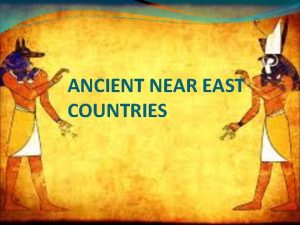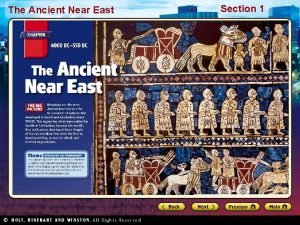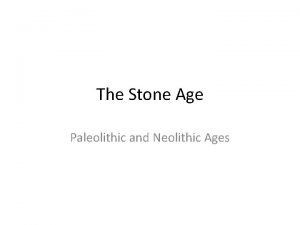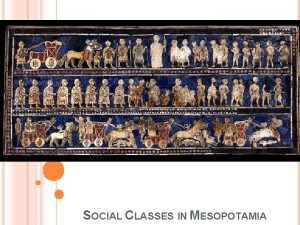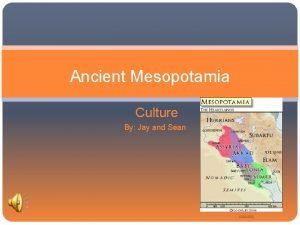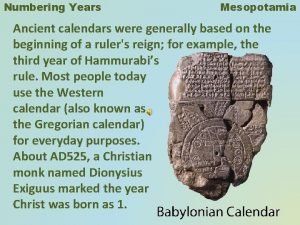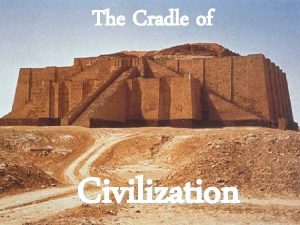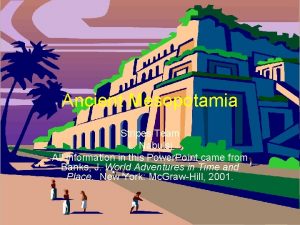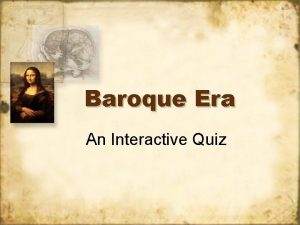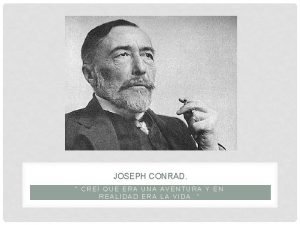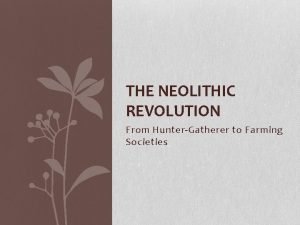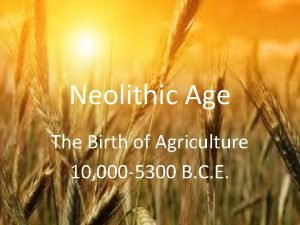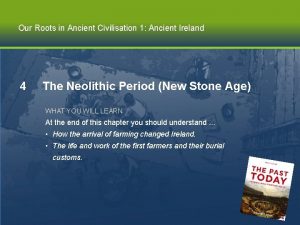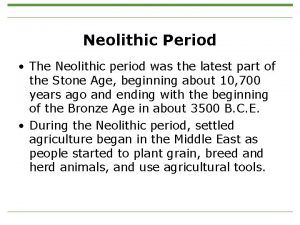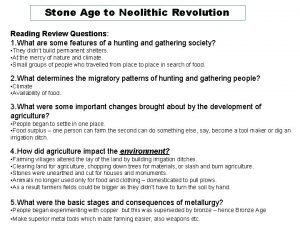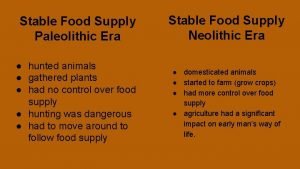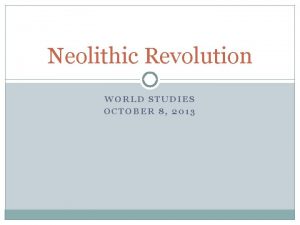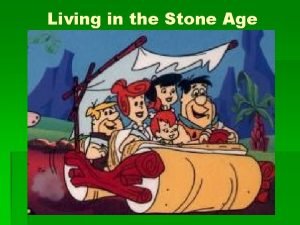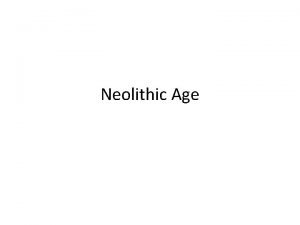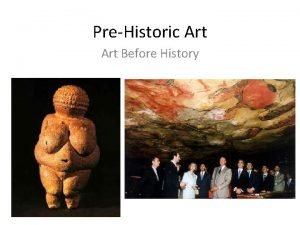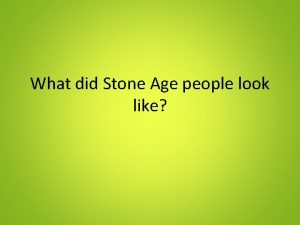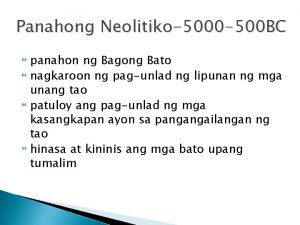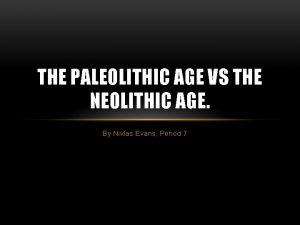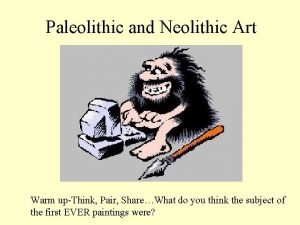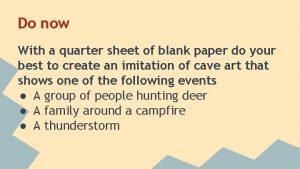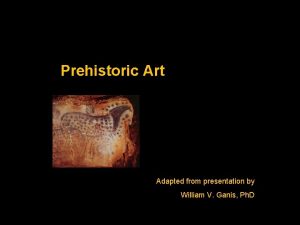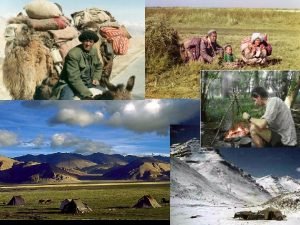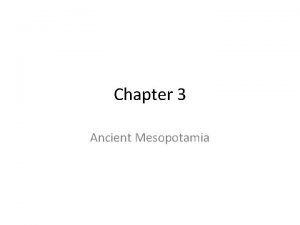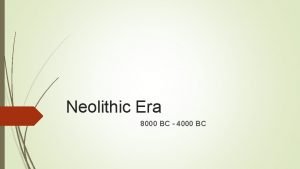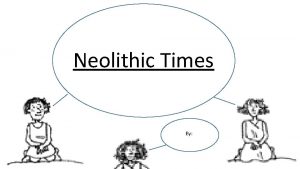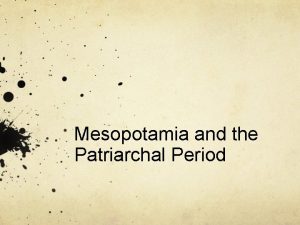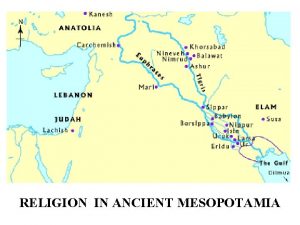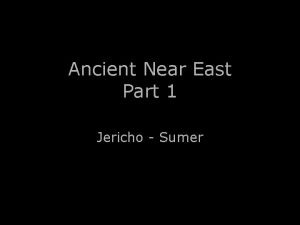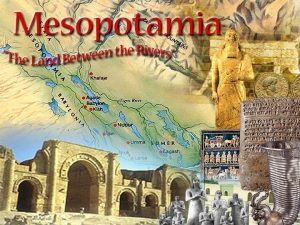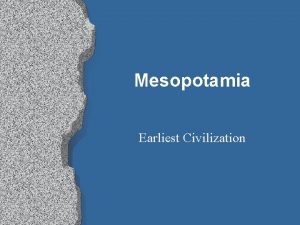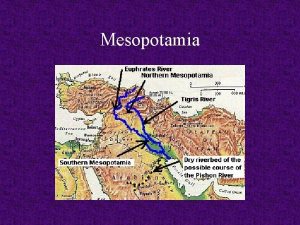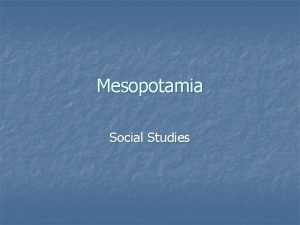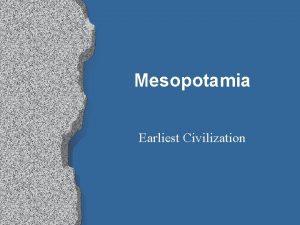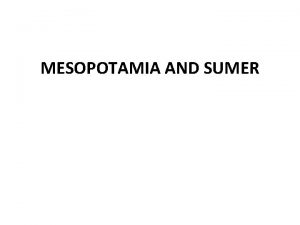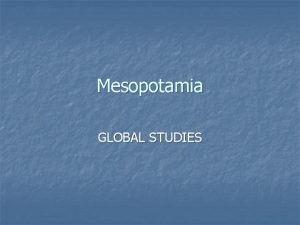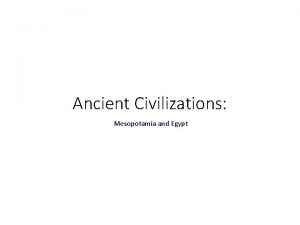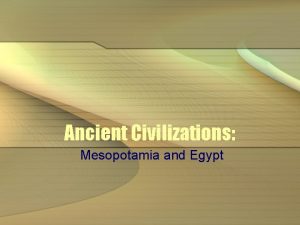The Ancient Near East Mesopotamia n Neolithic Era











































































- Slides: 75

The Ancient Near East Mesopotamia n Neolithic Era n 9000 -4500/4000 BC n Art History Vincent Baldassano n



Ancient Near East Farming began in the Middle East in an area called the Fertile Crescent Development of agriculture-irrigation systems (People noticed that seeds which had fallen on the ground grew into plants. They began to collect the seeds and plant them on purpose. The first crops grown were wheat and barley)

Neolithic Era Ancient Near East (con’t) Domestication of sheep and goats Earliest cities in Mesopotamia Copper smelting developed Development of complex urban societies Urban planning Mud-brick mainstay of architecture

Key Visual Art Historical Monuments n n n Babylon n Stele- Law of Hammurabi-1792 - 1750 BC, Basalt (stone) 7 feet by 28 inches Anatolia (Turkey) n The Hittites n Hittite War God, from Kings Gate, Hattusas Boghazkoy, Turkey, 1400 BC, 6 feet , 6 inches high Assyrian n King Assurnasirpal II hunting lions, from Nimrud, Irag, 883 -859 BC, Alabaster Relief, 3 feet by 8 feet Dying Lioness (detail from the Lion Hunt) from the palace of King Assurbanipal II, Nineveh, 668 -627 BC, Alabaster relief, Height 13 inches Neo-Babylonian n Ishtar Gate n C 575 BC, Glazed Brick Scythian n Stag, Russia, 7 th C BC, Gold, 12 ½ inches n Stag, 4 th C. BC, gold, bronze, siver, wood, 20 inches n n n

Inventions 1. 2. 3. 4. 5. Writing Poetry History Economic records Religious texts

Key Terms n n n n n Armature Mural Polytheistic n From Greek- Poly (many) n Theos-(God) Anthropomorphic n Human in form Cuneiform Cone mosaics Registers Inlaid Glyptic

The First Towns Jericho Near present day Jerusalem n n People lived houses made of mud brick n Dead were buried beneath their homes n Town was protected by a massive stone wall n Textbook Photo- “Neolithic Plaster Skull from Jerico” c. 7000 BC

The First Towns (con’t) n Catal Huyuk (pronounced chatal hoo-yook) was the largest of the early towns. Contained nearly 6000 people. n Catal Huyuk in Anatolia (modern day Turkey) n Deity – Mother Goddess made of clay reminiscent of the “Venus of Willendorf” n Town planned without streets, connected by roofs n skeletons were buried beneath floors and bences

Catal Huyuk c. 6500 -5500 bce. Largest neolithic site in ancient Near East. Deliberate city planning took place here. There were rooftop walkways/no streets. Preliterate society (no known written language)





Two cowrie shells were set horizontally into the eye sockets creating a ‘sleepy expression’ which resonates through to the • present day. It is thought that the jaw bone was removed intentionally and that the clay would have been built up to create a neat artificial chin. The plasterwork does not extend over the back of the skull, which was perhaps originally provided with some other material to look like hair. Separation of the skull was a common practice among the early farming populations. This example was found, together with six other skulls in a pile beneath the floor of a house. It is suggested that the heads preserved were those of venerated ancestors. They were kept for some sort of ancestor worship and then discarded after a generation or two.

The skull formed the basis of a sculpture. Below… on the surface of the skull there are the remains of clay and plaster. It was made over 9, 000 years ago. Then we would have seen little or none of the skull itself. Clay was built up around the skull and then plaster was applied to provide a smooth surface.



Mother Goddess, c. 6000 bce, baked clay, h. 8”, Chatal Huyuk, Turkey.

Mesopotamia n Near Eastern Conventions: Creation of composite view of human form n Legs and head in profile n Torso turned slightly n Eyes frontal



Sumarian

Ziggurat n Ziggurat- means raised up or high- a uniquely Mesopotamian architectural form n Imitation mountains as platforms for the gods who protected the city n Mountains believed to embody immanent posers of nature (life giving water that flowed in the plains and made agriculture possible) n Ziggurat considered a transition space between people and gods n Example of load-bearing construction- solid, step structures tapering towards the top with wide bases made of solid clay reinforced with brick an asphalt, white potter jars were embedded in the walls n Top of Ziggurat was the Temple





Nanna Ziggurat Ur, c. 2100 - 2050 BC Mud-Brick



Bull Lyre 2680 BC Wood, gold, Lapis Lazuli, & Shell From the tomb of Queen Pu-abi, Ur (modern Iraq)




Sumarian

Gudea with a temple plan Lagash, Iraq c. 2100 Diorite 29 inches high

Seated statue of Gudea, c. 2100 bce, diorite, Neo. Sumerian period, Tello (Lagash), Iraq.

Gudea with Temple Plan(left) Seated Gudea (right) c. 2150 B. C. E. 29" h. diorite

Note the similarities also how the artist consistently renders certain elements such as around the eyes and the shoulder/bice p/forearm

Statue of Gudea (standing figure) From Lagash c. 2120 BC Diorite Height 29 inches

Akadian






Neo- Sumerian




Stele (detail) Law code of Hammurabi Susa, Iran Hammurabi stands before the Akkadian sun god, Shamash


Hittite


Lion Gate (Royal Gate)Hattusas, Turkey




Audience Hall of Darius, Persepolis, Iran 500 bc


Neo-Babylonian


Ishtar Gate Babylon C 575 Glazed brick

Neo-Babylonian

Lamassu, from the gateway, Sargon. II’s palace at Dur, 720 BC, Limestone, Iraq



King Assurnasirpal II, Hunting Lions, Nimrud, Iraq, c 883 -859, Alabaster relief, 3 x 8 ft

Dying Lioness (detail of the great lion hunt), 668627 BC, Alabaster relief, 13 inches high, Iraq

Synthian

Stag, from Kostromskaya, Russa, 7 th. C, Chased gold , 121/2 in

Key Visual Art Historical Monuments n Babylon n Stele- Law of Hammurabi-1792 - 1750 BC, Basalt (stone) 7 feet by 28 inches n Anatolia (Turkey) n The Hittites n Hittite War God, from Kings Gate, Hattusas Boghazkoy, Turkey, 1400 BC, 6 feet , 6 inches high Assyrian n King Assurnasirpal II hunting lions, from Nimrud, Irag, 883859 BC, Alabaster Relief, 3 feet by 8 feet n Dying Lioness (detail from the Lion Hunt) from the palace of King Assurbanipal II, Nineveh, 668 -627 BC, Alabaster relief, Height 13 inches Neo-Babylonian n Ishtar Gate n C 575 BC, Glazed Brick. Scythian n Stag, Russia, 7 th C BC, Gold, 12 ½ inches n Stag, 4 th C. BC, gold, bronze, siver, wood, 20 inches n n

The End
 Laissez faire theory
Laissez faire theory Ancient near east countries physical education
Ancient near east countries physical education Physical activities of the primitive society
Physical activities of the primitive society Early empires in the ancient near east
Early empires in the ancient near east The ancient near east
The ancient near east Neolithic era characteristics
Neolithic era characteristics Jericho and aleppo
Jericho and aleppo Paleolithic age
Paleolithic age New stone age characteristics
New stone age characteristics Ancient mesopotamia social classes
Ancient mesopotamia social classes Ducksters ancient mesopotamia
Ducksters ancient mesopotamia Ancient mesopotamia calendar
Ancient mesopotamia calendar Ancient mesopotamia test
Ancient mesopotamia test Ancient mesopotamia timeline
Ancient mesopotamia timeline Ancient mesopotamia
Ancient mesopotamia Rugby style tackling
Rugby style tackling Near east university tourism and hotel management
Near east university tourism and hotel management East is east and west is west
East is east and west is west What is the horizontal movement of air called
What is the horizontal movement of air called Era uma estrela tão alta era uma estrela tão fria
Era uma estrela tão alta era uma estrela tão fria Baroque music quiz
Baroque music quiz Elizabethan or victorian
Elizabethan or victorian Creí que era una aventura y en realidad era la vida
Creí que era una aventura y en realidad era la vida Empiric era of pharmacy
Empiric era of pharmacy Ancient india vs ancient china
Ancient india vs ancient china Communication in ancient time
Communication in ancient time Mya hink age
Mya hink age Neolithic revolution
Neolithic revolution Neolithic characteristics
Neolithic characteristics Neolithic age
Neolithic age Join the neolithic revolution cartoon
Join the neolithic revolution cartoon Why was the neolithic revolution a turning point in history
Why was the neolithic revolution a turning point in history Birth of agriculture
Birth of agriculture Houses of neolithic age
Houses of neolithic age What change began the neolithic age, about 8000 b.c.e.? *
What change began the neolithic age, about 8000 b.c.e.? * Paleolithic mesolithic neolithic art
Paleolithic mesolithic neolithic art Neolithic
Neolithic Neolithic period timeline
Neolithic period timeline Stone age diorama
Stone age diorama Food supply paleolithic
Food supply paleolithic How did agriculture originate
How did agriculture originate Whats neolithic revolution
Whats neolithic revolution Neolithic social structure
Neolithic social structure Lesson 2 the neolithic revolution
Lesson 2 the neolithic revolution Cause and effect neolithic revolution
Cause and effect neolithic revolution Similarities of paleolithic and neolithic
Similarities of paleolithic and neolithic Neolithic
Neolithic Art before history
Art before history What tools did the neolithic use
What tools did the neolithic use Panahong neolitiko o panahon ng bagong bato
Panahong neolitiko o panahon ng bagong bato Backwash effects human geography
Backwash effects human geography Paleolithic versus neolithic
Paleolithic versus neolithic Neolithic rap
Neolithic rap Paleolithic age vs neolithic age
Paleolithic age vs neolithic age Paleolithic vs neolithic art
Paleolithic vs neolithic art Neolithic revolution
Neolithic revolution Neolithic
Neolithic What was the neolithic revolution? *
What was the neolithic revolution? * Gudea
Gudea Neolithic revolution
Neolithic revolution Alleluia hat len nguoi oi
Alleluia hat len nguoi oi Sự nuôi và dạy con của hổ
Sự nuôi và dạy con của hổ đại từ thay thế
đại từ thay thế Diễn thế sinh thái là
Diễn thế sinh thái là Vẽ hình chiếu vuông góc của vật thể sau
Vẽ hình chiếu vuông góc của vật thể sau Công thức tính thế năng
Công thức tính thế năng Thế nào là mạng điện lắp đặt kiểu nổi
Thế nào là mạng điện lắp đặt kiểu nổi Tỉ lệ cơ thể trẻ em
Tỉ lệ cơ thể trẻ em Lời thề hippocrates
Lời thề hippocrates Vẽ hình chiếu đứng bằng cạnh của vật thể
Vẽ hình chiếu đứng bằng cạnh của vật thể Phản ứng thế ankan
Phản ứng thế ankan Quá trình desamine hóa có thể tạo ra
Quá trình desamine hóa có thể tạo ra Môn thể thao bắt đầu bằng chữ đua
Môn thể thao bắt đầu bằng chữ đua Hình ảnh bộ gõ cơ thể búng tay
Hình ảnh bộ gõ cơ thể búng tay Sự nuôi và dạy con của hươu
Sự nuôi và dạy con của hươu điện thế nghỉ
điện thế nghỉ

